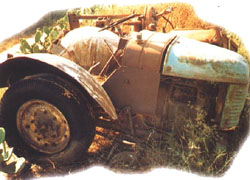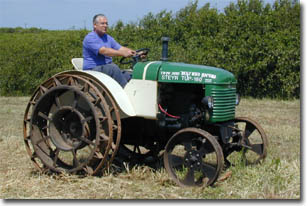Steyr, TUP 180, 1948, Herut
Donation from the Zilberman Family, Herut
This is Zilberman's 1948 Steyr tractor from Moshav Herut. It was purchased new from a Czech immigrant who arrived with the tractor at Moshav Ein Ayala. When the driver's seat wore out, it was replaced with a toilet seat. After it stopped being used for farm work, the tractor became a shooting target. The original iron wheels were found nearby.
Arnon Zilberman (Yosef's grandson) was the last to drive the tractor on its journey to plot 6, between the cypress trees in the Herut orchards. There, the tractor got stuck and remained for many years.
Arez, who knew about the tractor's existence, approached Arik Zilberman (Yosef's son) looking for the vehicle, but he didn't know its whereabouts. His brother Amram, however, remembered that Arnon (his son) probably left it in the orchard after it got stuck and attempts to start it failed. This is how the tractor was found, ruined and dismantled.
There are several versions of how the tractor arrived at the museum. One version states that Yehuda Levin and Zvika Maor from Ein Vered came with a truck and a shovel to retrieve the tractor. Yehuda, with the shovel, dragged the tractor to the road, and Zvika loaded it onto the truck and drove it to the museum. Others claimed that the late Avner Lazar towed it to Ein Vered with his Fiat tractor.
All this happened in 1992/1993. This was the third tractor to reach Arez (the first two tractors were from Ein Vered). At the museum, they repaired, fixed, arranged, and revived the tractor, bringing it back to life.
The tractor participated in a salute march in Jerusalem organized by the regional councils in Israel, held on the eve of Jerusalem Day between 2002 and 2006.
To our knowledge, the tractor was bought by Zilberman from a family in Moshav Ein Ayala. The tractor was manufactured in 1948 in Austria.
Udi recalls that when Zilberman used to start the tractor, you could hear it all over the moshav: "Boom... boom... boom..." Amotz, who lived nearby, still remembers the sounds of the tractor starting in the morning.
A Journey in a Time Machine Dedicated to my uncle Zohar from his nephew, Chen Nardi
I confess that this is not how I imagined our meeting after fifty years without seeing him. He stood in a row with dozens of his brethren, some of whom were much taller and heavier than him. On his chest was a white sign with his name in Latin script: "Steyr." He reminded me more of a criminal in a lineup than the hero of my childhood. Most disappointing of all: he wasn't as big as I imagined him to be. I remembered him standing atop a pile of gravel in my grandparents' yard in Moshav 'Herut,' ready for any call. Big and strong, with a booming voice that silenced every other sound around him. When I was little, really little, I thought he stood there at the top of the gravel pile because of his leadership position. After all, he was at the center of the farm's activity. Like a general surveying his troops, he stood there watching the chickens in their coops, the chicks in the nearby brooder house, the cats trying to hunt the mice hiding inside the feed barrel next to the chicken coop, and the sprayer platform that stood in the corner of the shed on its two enormous iron wheels, sadly crouching on its rusty drawbar as if waiting to be harnessed to a horse or a tractor.
When I was seven, old enough to face the cruel facts of life, my uncle Zohar told me, in a matter-of-fact voice, the unflattering truth about the green giant. A truth that was hard for me to hear: the green Steyr stood there at the top of the gravel hill not because of its high status, nor because of its Austrian origin, crowned with the glory of the Austro-Hungarian Empire. But simply because its battery had run out, and my grandfather insisted on not replacing it with a new one for reasons of economy. That's how it happened that the Steyr could only be started with the momentum of going down the gravel hill. Thump, thump, thump. First, three explosions that wouldn't shame three explosive charges, and then a series of smaller explosions from its pistons, and black clouds of burnt diesel trailing behind it like dust clouds left behind by a warhorse.
If I likened the Steyr to a "general," then my uncle Zohar, who was fifteen at the time, seemed to me, a five-year-old child, like the "general of generals." "Hani, climb on!" his call still echoes in my ears today. "Hani, climb on!" He held out a brave hand to me and sat me between his knees. "Come, drive like a grown-up." A phrase larger than life. I held the steering wheel, which seemed to me like the Ferris wheel at the amusement park, in my small hands. My joy knew no bounds. I turned the wheel right and left, and the 'green giant' obeyed me. Zohar only allowed me to hold the wheel on the main sand road between the orchards. Inside the orchard, he took the wheel back. The Steyr galloped between the rows of citrus trees, the sprinklers sprayed cool droplets on us that sent shivers down my spine, branches lashed my face, oranges bumped into me. I imagined we were in a fierce battle and my heroic uncle Zohar was swiftly passing on his noble horse between the enemy soldiers, rescuing both of us. And all the while, I was riding behind the back of "Steyr," the mighty warhorse, hugging him from behind.
In the afternoon, while the yard was taking its midday nap, when my grandfather was swatting flies with his rubber stick, and the chickens in their coops were too full to hope I came to feed them, I sneaked and climbed onto the Steyr. I turned the steering wheel back and forth and imagined that he and I were galloping through the fields. The front wheels pushing the dune sand of the paths, and in winter, traversing the huge puddles between the orchards.
The fenders were not original. "We replaced the original fenders because they were already rotten from rust," said Arez, the museum director. I was disappointed. There are transitions in every adult's life: weaning from mother's milk, weaning from a pacifier, finishing kindergarten and moving to first grade, a Bar Mitzvah, and so on. My transition from childhood to adulthood was symbolized by the move from the small child's seat on Zohar's knees to the enormous fender of the Steyr. "Hold on tight here," Zohar said, and we set off. I trembled with fear but tried to look "cool." The courage and ability to stay on the fender despite the violent bumps were, for me, one of the first tests of masculinity. I survived. I didn't fall between the tractor's wheels, nor did I beg to get off the fender. I earned my entry into the men's club, the Zilberman tribe. On condition, of course, that as an urbanite, I was always under suspicion of being soft. (My sneezes from the feed dust and the citrus blossom were a constant threat to my membership in the men's club. After all, a real man can only be a moshavnik, and a real moshavnik who is allergic to citrus blossom and chicken feed is a contradiction in terms.)
I was betrayed for the first time by Zohar and the Steyr when I was 7 and Zohar was 17. And so it was: one Friday, Zohar cleaned the Steyr as a knight cleans his horse upon returning from battle. He washed the wisps of straw and broken branches that clung to its radiator, pulled out crushed oranges mixed with red soil from between its tire treads. He showered, combed his black forelock, put on cologne, and dressed in a white shirt. Even then, he stood about six feet tall, a sturdy and handsome young man. "I'm going to Kfar Haim," he said, climbed onto the Steyr, and disappeared with a roar, as if defiant with his surging youth against the silence of the moshav dozing on a Friday afternoon. I didn't understand what was in Kfar Haim that justified such a celebration about which I knew nothing, nor had any part in. When he returned at dusk the next day and a girl sat on the Steyr's fender, my breath was taken away. She sat on the Steyr's fender in "my" spot and looked beautiful, like something out of a movie. She looked at my beloved uncle with boundless admiration, and a happy smile spread across his face. I was angry and jealous. I was angry that my uncle had abandoned me for a girl who had no connection to our Steyr. And I was jealous: would I ever be able to drive the Steyr with a beautiful girl sitting on the fender, admiring me?
"Hani, climb on and drive," Zohar said, and my joy knew no bounds. Today I am 57, Zohar is 67, and both of us stood there in the tractor museum in Ein Vered, as if we had traveled together in a time machine and returned to our childhood and youth. "Hani, climb on and drive," Zohar said again, and I, a 57-year-old child, shone again like before. I climbed onto the Steyr, and Arez Milstein, founder and director of the Tractor Museum, said: "Press the starter." My childhood in Moshav Herut returned to me at once. I joyfully breathed in the burnt diesel smoke that on normal days I despise as an environmental pollutant, and remembered the addictive blend of my longing for wet red soil, citrus blossom, juicy oranges, chicken feed dust, the smell of golden-winged chicks, my grandmother's cooking, and the scents of the laundry room in the house's basement.
My thread of memories was cut short by the sputtering sound of an impudent ATV that sped past the museum at such a speed that the Steyr could not even dream of. I wondered what the Steyr thought when it noticed the gleaming vehicle that passed it with a roar that deafened even its ancient engine, which had been brought back to life with hard work and the loving hands of the Tractor Museum Association members in Ein Vered. For me, the visit to the museum was an experience of my fading youth and a return to my childhood days at my grandparents' house.

